|
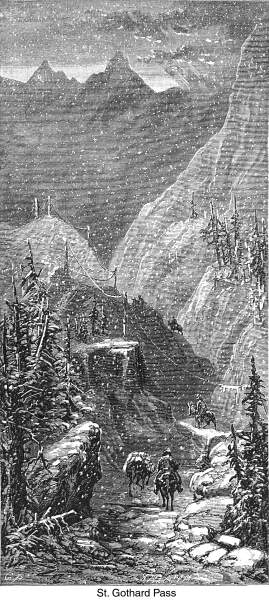 THE ST. GOTHARD TUNNEL. THE ST. GOTHARD TUNNEL.
Harper's—Vol. LVII—No. 341—42
ca. 1878
FEW Americans visiting the World's Fair at Paris this year
will fail to examine a magnificent map or panorama they will see
there of the Great St. Gothard Tunnel. It is in the Swiss Department,
and is not only interesting as locating the route of the greatest
piece of engineering in the world, but as showing bits of the
most picturesque scenery of the Alps.
To go under the Gothard Pass, as I had gone over it, had long
been a desire of my heart, but there had always been difficulties
in the way.
"It is a dirty, dangerous job," said a friend of
mine recently, when I told him I was going up into the mountains
in winter—and more, that I was going right under them and
into the great tunnel. "You'll not do it," he continued,
laughing and shrugging his shoulders—"I know you won't.
And I'll tell you why. In the first place, the awful gases in
there would suffocate you, the rivers of water would drown you,
and the explosions of dynamite would blow you up. Again, you would
back out before going in a mile; and lastly, you couldn't get
permission to go in at all."
I knew there was dynamite there, and bad gases and rivers of
water, but I reasoned that what several thousands of Italian workmen
could live amid for months I certainly could endure for a few
hours.
As to permission, I had that in my pocket—a little red
ticket, printed in French, and saying, "Pass Mr. B—and
two friends into the tunnel at Goeschenen." I had, besides,
a letter of introduction from the chief engineer to the principal
officer in charge, as well as some good recommendations from Engineer
Lauber, the affable and competent secretary at head-quarters.
It was midwinter, and the snow on the Alps lay all the way from
ten inches to twenty feet deep. Our route took us by rail from
Zurich to Lucerne, and a three hours' steamboat ride through the
wonderful scenery of the Lake of the Forest Cantons brought us
to Fluelen, the real gateway to the St. Gothard Pass, and a district
rich with memories of William Tell. Sledges carried us four hours
up the pass, and before the sun could peep over the broad shoulders
of the Bristenstock we were in the offices of the company at Goeschenen.
My letters and my pass were presented, and, after dinner, I
was to be allowed an inspection of the great tunnel.
Before entering into any description of it, however, and the
methods by which it is being built, it might not, perhaps, be
amiss, just here, to recall in a few words something of the history
of this vast undertaking.
There are men living to-day in Switzerland and Italy whose
life-dream has been a tunnel under the Alps. Many schemes have
been investigated, and many schemes have failed.
These mighty barriers of mountains have for ages divided peoples
that but for them might have been of one language, one interest,
alike in laws and customs. For five hundred years there was but
a stony path across the Helvetic Alps, where the St. Gothard post-road
was afterward built; and it is but a century since the first vehicle
on wheels was dragged over the pass, at an expense of several
hundred dollars. Till that time, the traffic between two nations
was borne on the backs of mules and men, who struggled, at the
risk of death, along narrow stony ways, winding around glaciers,
high mountain peaks, and yawning gulfs: 16,000 persons and 9000
horses climbed over these dizzy heights annually.
There were scarcely fewer dangers to be encountered by the
bold trader even forty or fifty years ago—sudden storms,
almost eternal snows, avalanches, falling rocks, dangerous and
unbridged torrents, and even robbers. Nature and man conspired
to make the path of the St. Gothard one of awful risk and dangers.
It winds among granite pyramids and peaks nine to ten thousand
feet in height, and the road itself reaches an elevation of nearly
seven thousand feet. Even now the snows on the pass are so deep
and the dangers are so great that commerce and travel over the
St. Gothard cease for half the year entirely, the mails being
carried over by messengers. Such are a part only of the disadvantages
arising to some sixty or seventy millions of people from this
mighty mountain wall between Switzerland and Italy.
The building of the Mont Cenis Tunnel through the Savoy Alps
to France, and the Brenner Road to Austria, have made it absolutely
necessary for Germany and Switzerland to choose between losing
the commerce and travel of the South, and building a mountain
railroad, and a series of tunnels that shall eclipse any thing
of the kind in the world. The world knows how they have chosen.
The enterprise was too enormous for private undertaking or
for private capital. In 1871, Italy, Germany, and Switzerland
voted large subventions for the building of a road, to be commenced
at once, running from the Lake of Lucerne, in Switzerland, to
Lake Maggiore, in Italy, a distance of 108 miles. Twenty-one per
cent., or nearly 120,000 feet, of all this distance, was to be
tunnelled through mountains of granite.
The total length of the main tunnel, which enters the Alps
at Goeschenen, in Switzerland, and emerges at Airolo, in Italy,
is 48,936 feet. A number of the smaller tunnels, bringing the
road up to the proper level in the Alps, exceed 7000 feet. On
the Lake of Lucerne, too, there will be important tunnels and
galleries cut alongside of or under the celebrated Axenstrasse,
high above the waters of the lake.
At the time the international treaty for this great undertaking
was signed it was believed that the -work could be done for the
sum of 187,000,000 francs. A company was organized, with 34,000,000
francs of stock, in £20 shares, and 68,000,000 francs of
mortgage bonds. Italy presented the undertaking with 45,000,000
francs. Germany and Switzerland each gave 20,000,000 francs. The
work, however, was not more than fairly under way when it was
discovered, to the astonishment of every body, that an awful mistake
had been made in estimating the costs, and that, instead of 187,000,000
francs, 289,000,000 would be required to complete the work as
at first proposed—a blunder in estimates of 102,000,000 francs.
This blundering calculation threatened all sorts of bad results.
The stock of the company ran down to a minimum, and hundreds of
families were nearly ruined by the collapse. The bonds shared
in the crash, and even the most ardent friends of the enterprise
feared that the money which had been so lavishly given was buried
under the mountains forever. It became a serious question whether
the works would not have to be completely abandoned. There certainly
was no choice, except to lose all that had been done, or to add
many millions more to the subventions. The times were hard, financial
crises were imminent every where, and war was raging on the Continent.
Every body was discouraged. Some of the little cantons of Switzerland,
which would receive the most benefit from the completion of the
tunnel, refused to lift a hand or to spend another dollar.
In the face of all opposition, however, the money has, at this
writing, been almost raised. The three countries, parties to the
treaty, have added largely to their subsidies, and the leading
Swiss railways and cities have each voted sums proportioned to
the advantages they hope to reap. The work goes on—in fact,
has never stopped.
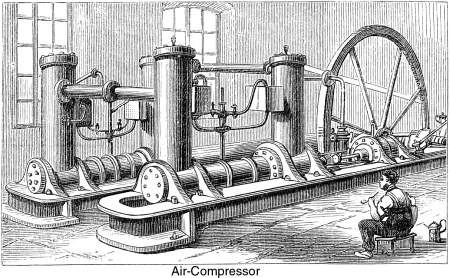 The contract
for this enormous work is most interesting. It was granted to
Mr. Louis Favre, of Geneva. By its terms Mr. Favre promises to
deliver the works of the tunnel, completed, by the 1st of October,
1880. For each day the work may be done before that time the company
agrees to pay him $1000. On the other hand, however, the contractor
is bound to pay handsomely for all delays. For every single day
in arrear of contract he forfeits $1000. If delay continue six
months, the forfeit is $2000 per day; and should be one year in
arrear with his work, he surrenders the contract, and forfeits
$1,600,000, which he, and his friends for him, have deposited
with the company as security. The contract
for this enormous work is most interesting. It was granted to
Mr. Louis Favre, of Geneva. By its terms Mr. Favre promises to
deliver the works of the tunnel, completed, by the 1st of October,
1880. For each day the work may be done before that time the company
agrees to pay him $1000. On the other hand, however, the contractor
is bound to pay handsomely for all delays. For every single day
in arrear of contract he forfeits $1000. If delay continue six
months, the forfeit is $2000 per day; and should be one year in
arrear with his work, he surrenders the contract, and forfeits
$1,600,000, which he, and his friends for him, have deposited
with the company as security.
On January 1, 1877, the headings, or a sort of advanced
gallery eight feet square pushed forward at the top of the tunnel,
were half-way in. Whether the gigantic work can really be completed
within the time specified is a grave question for Mr. Favre. Opinions
differ, and even engineers can do little more than guess.
After dinner Mr. Zollinger, the second engineer at the works
in Goeschenen, kindly called and invited our party to examine
the great air-compressors and machine-shops outside the entrance
of the tunnel, The machines with which the granite is being bored
are working away, several miles off, under, the heights of Monte
Prosa. The power moving these machines is quietly lying out here
on the hillside, locked up in four great iron boilers, or reservoirs.
It is compressed air. These boilers are connected with the machines
working inside the tunnel, and bear the same relation to them
that the steam-boiler does to the engine. Steam could not be conducted
through pipes for miles, as it would cool and condense; neither
could shafting nor belts be made to act at such immense distances.
With air, however, the thing becomes easy and perfectly simpler
The improved air-compressors which supply this force stand in
rows in a long low building near the tunnel. They are simply vast
air-pumps, compressing the air to a density of from seven to twelve
atmospheres.
As I am not writing for engineers alone, I will not attempt
to describe these immense machines in all their details, but will
content myself with saying that their application, or rather the
application of compressed air to this purpose, is not new, as
air-engines and boring-machines, though of a far inferior construction,
were used in driving the Hoosac Tunnel in America, the Mont Cenis
in Savoy, and at other different works of this character. They
may be operated either by steam or by water power.
Those at Goeschenen are actuated by ten Girard turbines, which
are driven, by a heavy stream of water, conducted from a point
more than 2000 feet along the mountain and 200 feet higher up,
where the river Reuss fortunately dashes by. The water is first
filtered in an immense basin of masonry, in order that the compressors
may not be injured by sand, etc., and is then carried down to
the compressing-house by iron tubes thirty-three inches in diameter.
This force of water, dashing through the turbines, enables
the compressors now in operation to deliver into the reservoirs
outside 3,620,000 cubic feet of air per day, equalling some 25,000
cubic feet, compressed to six atmospheres, per hour.
This compressed air passes from the reservoirs to the machines
in the tunnel through an iron tube six inches in diameter, and
serves not only to drive the drills, but to ventilate the tunnel.
Of course, as the air escapes from the drill engines inside, its
tendency is to force the gases and smoke backward, and at last
out of the tunnel. These gases and smoke are produced in part
from natural causes, but largely from dynamite explosions, as
well as from the burning of thousands of lamps, and the respiration
of the workmen.
An idea may be had of the condition of the atmosphere inside
the tunnel if it be remembered that not less than 210,000 cubic
feet of this gas and dense smoke have to be forced out of the
tunnel daily. The compressed air escaping from the boring-engines
at the head of the tunnel, however, is supposed to be more than
sufficient for this task of expulsion, as its bulk averages at
both ends about 7,000,000 cubic feet per day.
Still, the escaping air, powerful as it is, must combat the
column of air already filling the tunnel for several miles back.
The result is that the ventilation of the tunnel is, and always
will be during the blastings, very incomplete.
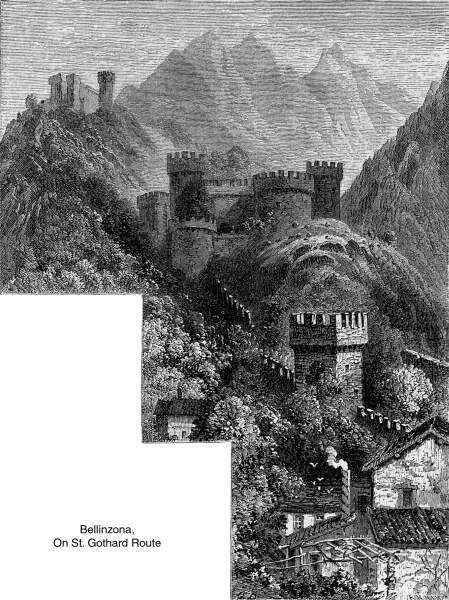 Before entering
the tunnel it is worth while to consider the strange-looking locomotives
which serve for pulling in trains laden with rock, mortar, iron,
etc., and for pulling out trains laden with the debris of the
tunnel: 400 car-loads of debris are taken out of the two ends
of the tunnel daily. Of course such a circulation of steam locomotives
with steam and smoke and ashes escaping, would be unendurable
in a long and half-ventilated hole in the ground. Something had
to be done; other means had to be sought for, and Mr. Favre concluded
to try air locomotives. He first experimented with small engines
and very low pressures, and finding them a success, he has introduced
large engines, working with a pressure of from twelve to fifteen
atmospheres. To compress air to this extent, special compressors
were built and new reservoirs added. Before entering
the tunnel it is worth while to consider the strange-looking locomotives
which serve for pulling in trains laden with rock, mortar, iron,
etc., and for pulling out trains laden with the debris of the
tunnel: 400 car-loads of debris are taken out of the two ends
of the tunnel daily. Of course such a circulation of steam locomotives
with steam and smoke and ashes escaping, would be unendurable
in a long and half-ventilated hole in the ground. Something had
to be done; other means had to be sought for, and Mr. Favre concluded
to try air locomotives. He first experimented with small engines
and very low pressures, and finding them a success, he has introduced
large engines, working with a pressure of from twelve to fifteen
atmospheres. To compress air to this extent, special compressors
were built and new reservoirs added.
The appearance of these air locomotives is that of an immense
tube or cylinder lying on low wheels. They are made of steel,
and the engine part does not differ materially from that of any
ordinary locomotive. It is only that air and not steam is used
as a motor.
Should these travelling air reservoirs become exhausted at
any time on the trip into the tunnel, additional air may be turned
on through cocks and rubber pipes from a special air tube which
is laid for this purpose.
The development of this principle of an air locomotive will
doubtless yet settle the vexed question of the ventilation of
long tunnels.
When our intelligent cicerone, Mr. Zollinger, had shown us
the air-compressors, the turbines, the repair shops, and trip-hammers
worked by compressed air outside the tunnel, he transferred us
to the attentions of his deputy, Mr. Isaac, who promised to show
us inside the tunnel, or what, he laughingly termed "a glimpse
at the bowels of hell."
We had worn pretty good clothes from Zurich, and had adorned
ourselves with collars and cuffs of immaculate whiteness that
very morning.
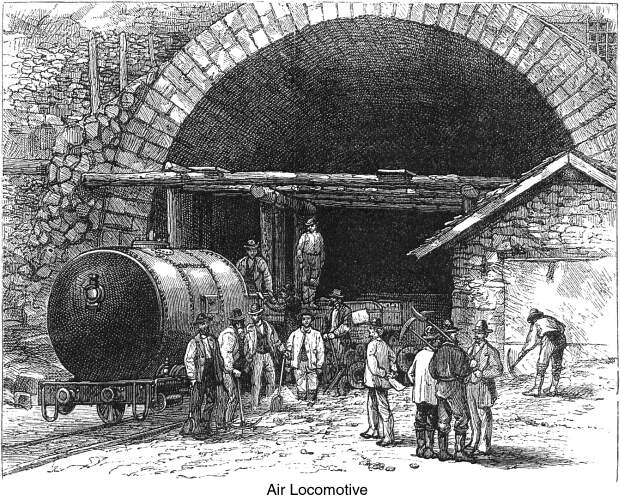
"Es macht nichts," said our lively conductor;
"a white cuff can't hurt a coal mine."
We were invited to strip off, in part, and in a few minutes
we were arrayed in sole leather boots reaching to the thighs,
little pea-jackets lined inside with petroleum and outside with
mud, and old slouch hats heavy and soiled enough to have been
bullet-proof. We were then each given all antique-looking petroleum
lamp, with rod attached, to carry in the hand.
"Now jump right up here beside me on the locomotive,"
said our friend, "and you need not light your lamps until
you are in, as the current of air from the moving train would
extinguish them."
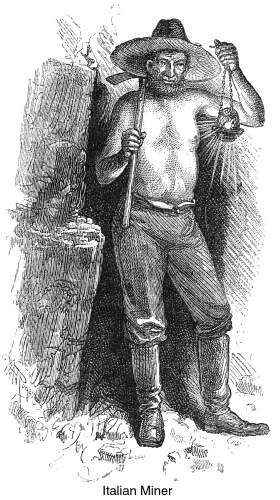 Four of us
with the engineer stood on the little cow-catcher platform at
the front end of the engine, and were soon hurled off into the
darkness. The screaming of the engine whistle right at our ears
was frightful, and the darkness was so utter and the smoke so
thick we fancied we could feel them with our hands. The gases
began to be almost unbearable, and the miscellaneous noises throughout
the tunnel something terrific. Four of us
with the engineer stood on the little cow-catcher platform at
the front end of the engine, and were soon hurled off into the
darkness. The screaming of the engine whistle right at our ears
was frightful, and the darkness was so utter and the smoke so
thick we fancied we could feel them with our hands. The gases
began to be almost unbearable, and the miscellaneous noises throughout
the tunnel something terrific.
I presume our train was not running fast, and yet it made so
much noise, and the surroundings were so unusual, it seemed as
if I had never in my life bounded along at such a rate. I had
had many a strange ride, too, before, but never had I felt so
completely helpless, or more likely to be snuffed out by the unseen
should any thing happen to the rails, or to the novel machine
on which we were riding. As we rushed by dripping walls, and saw
here and there ghoul-like figures with dim lamps hiding behind
rocks or, in deep niches, I involuntarily recalled what our conductor
had said of a glimpse of the bowels of hell.
It was impossible to speak and be heard, I might as well have
addressed myself to the granite walls of the tunnel as to have
attempted a word to either of my companions. Suddenly our locomotive
gave one extra, unearthly yell, and stopped. We alighted, got
our lamps burning, and with a little motion on our own feet soon
felt ourselves again. The engine sped back, screaming and rattling
like the voices of Milton's damned.
We now started forward in the tunnel on foot, and, as we recovered
our breath, had abundant time to look about, though there seemed
something fatally wrong with the perspective of the picture of
which we formed a part.
The air was so thick lights could not be seen twenty yards
ahead of us, and we all walked close together for fear of being
lost or tumbling into some subterranean hole.
Far ahead of us we heard the dynamite explosions, sounding
like heavy mortars in the midst of battle. In some places where
we were, walking the water was nearly a foot deep, and again it
came through crevasses above our heads like April showers. Our
conductor tells us that on the Airolo side of the tunnel the waters
have sometimes come in at the rate of 4000 gallons per minute,
and in such torrents as to even upset the workmen and carry away
the tools. Again, an occasional spring would burst out in a stream
as thick as a man's arm, while the track for the drills was frequently
laid in rushing water two feet deep. This water comes from springs
in the mountains about us, and from eternal snow-fields lying
in the sunshine thousands of feet above our heads.
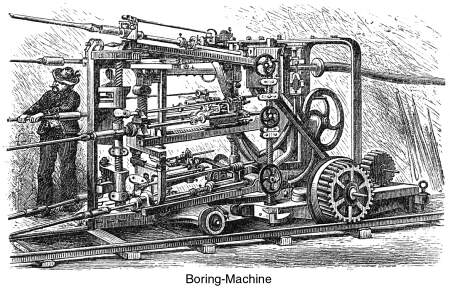 It is very
impressive to reflect that, as we stand here in the dim light
of the tunnel, far above us are lofty mountains and fields of
snow, tumbling avalanches and roaring torrents. Almost above us
are the peaks of the St. Gothard, reaching above the clouds; and
there, too, is the rapid, roaring river Reuss, with its leaping
waterfalls, and the Devil's Bridge, where French and Austrian
soldiers met in deadly conflict. Up there, too, are the bright
sunshine and the cold snow of the winter, and the diligences and
sledges filled with freezing passengers, while we are melting
under 80 degrees Fahrenheit of heat, and the Italian workmen are
almost naked. There, too, above our heads, in the glistening glaciers,
are the first rippling of the baby Rhine. Behind us are the cold
hills of Switzerland. In front of us, and just outside those granite
rocks, is sunny Italy. How strangely we feel! It is very
impressive to reflect that, as we stand here in the dim light
of the tunnel, far above us are lofty mountains and fields of
snow, tumbling avalanches and roaring torrents. Almost above us
are the peaks of the St. Gothard, reaching above the clouds; and
there, too, is the rapid, roaring river Reuss, with its leaping
waterfalls, and the Devil's Bridge, where French and Austrian
soldiers met in deadly conflict. Up there, too, are the bright
sunshine and the cold snow of the winter, and the diligences and
sledges filled with freezing passengers, while we are melting
under 80 degrees Fahrenheit of heat, and the Italian workmen are
almost naked. There, too, above our heads, in the glistening glaciers,
are the first rippling of the baby Rhine. Behind us are the cold
hills of Switzerland. In front of us, and just outside those granite
rocks, is sunny Italy. How strangely we feel!
Our conductor stops us to name the strata of rock through which
we are walking. The first 7000 feet at the Goeschenen end had
been through dark gray granite or granitic gneiss; then followed
1000 feet of schistous gneiss, lying in vertical ledges; then
500 feet of crystalline limestone, with here and there a streak
of black serpentine, followed by 3000 feet of micaceous schists,
and some 20,000 feet of gneiss rich in mica. This is followed
again by 5000 feet of schistous gneiss, with threads and lumps
of quartz, and nearly 10,000 feet of mica schist, ending on the
Italian side with some 2000 feet more of mica schist mixed with
gneiss and rich veins of quartz. Such were the calculations made
by the geologists from the mountains above the tunnel, and the
boring so far has proved these observations to have been pretty
nearly correct. But little gold, silver, or other precious ore
has been met with, and even stone-coal has failed to put in an
appearance, much as it would be welcomed by the Swiss, who have
scarcely a pound of coal in their whole Alpine country.
The tunnel has about the same dimensions, except in length,
as the Mont Cenis Tunnel; that is, it is, in round numbers, twenty-four
feet in width at sleepers, twenty-six feet wide at springing of
arch, and nineteen feet high between sleepers and centre of arch.
It starts into the mountain at a point 3639 feet above the sea,
and comes out at Airolo, on the Italian side, 3757 feet
above the sea-level.
On the north axis the tunnel ascends one foot in every 172
feet, or about 142 feet in traversing the distance of 24,462 feet.
It then follows a summit or level line for the next 591 feet,
when it descends to Airolo, 24,279 feet farther, at a gradient
of one in 1000. The highest point in the tunnel, hence, is 142
feet above the entrance at the north end, and, twenty-four feet
only above the outlet at the south. These gradients are for the
purpose of permitting the water to pass off through a channel
of masonry cut between the two tracks of rails toward either end.
Almost the entire tunnel is being arched and lined with solid
masonry, eighteen to thirty inches in thickness, and that, too,
in places where the granite and serpentine blocks seem to the
ordinary observer the perfection of solidity.
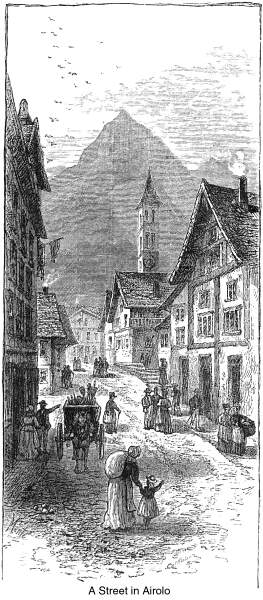 As we advance
farther we come upon hundreds of men working in groups, drilling
and blasting rock, loading cars, and building up the masonry.
The tunnel here, seems better ventilated, and the lights moving
about every where look strange enough. The workmen are all Italians.
No other workmen, says our conductor, will accept so much toil
and danger for so little pay. The Swiss and Germans will not,
and the French will not, so the illy fed Italian has it all to
himself. Like John Chinaman, he can live on little and work cheaply.
It has never occurred to the rest of the working classes in Switzerland,
however, that they should adopt the California method, and drive
off or murder the Italian Chinaman on account of his cheap labor. As we advance
farther we come upon hundreds of men working in groups, drilling
and blasting rock, loading cars, and building up the masonry.
The tunnel here, seems better ventilated, and the lights moving
about every where look strange enough. The workmen are all Italians.
No other workmen, says our conductor, will accept so much toil
and danger for so little pay. The Swiss and Germans will not,
and the French will not, so the illy fed Italian has it all to
himself. Like John Chinaman, he can live on little and work cheaply.
It has never occurred to the rest of the working classes in Switzerland,
however, that they should adopt the California method, and drive
off or murder the Italian Chinaman on account of his cheap labor.
These Italians work eight hours, and they receive from three
to six francs a day, boarding themselves. Of course it is a small
percentage of them who receive the maximum. wages; and yet, strange
as it may seem, they save more than one-half the money paid them,
and send it to their needy families in the dominions of King Humbert.
Their food is extremely limited in quantity, and is wretched in
quality, consisting largely of polenta, or a sort of Indian meal
porridge. Meat they never taste at all. They are contented to
receive their forty or fifty cents a day for hard work, if they
can only escape wounds and death from the bad gases and the thousand
accidents to which they are liable every moment of their lives
in the tunnel. Alas! they do not escape, for every week records
its disaster, either from explosions and flying rocks, falling
timbers and masonry, or railway accidents, breaking machinery,
etc. They have their "striking" troubles, too, with
fatal endings. Our conductor grew excited when he related the
story of one of these striking episodes.
"I was standing right here," he said, "in a
niche in the wall, superintending some work, when I heard, all
of a sudden, a tremendous shouting of many voices. I looked ahead
of me into the darkness of the tunnel, and saw perhaps a thousand
lights rapidly approaching and I heard the words, 'The mine! the
mine! Run for your lives! Gas! gas! Run!' In a minute thousands
of half-naked workmen were rushing by we like a herd of mad buffalo.
Some hold handkerchiefs to their months, some their hands only,
or bits of garments. They were running over each other, and their
hallooing was perfectly terrific. I shouted at them to learn what
was wrong. No man stopped. I could only distinguish the words,
'The mine! the mine! Run for your lives!' I jumped from the niche
where I was standing, and ran—ran for my life—for I
now feared some awful explosion had taken place, or that an under-ground
stream had been struck, and that the tunnel was filling with water.
I thought, too, I felt the deadly gases being rapidly pushed after
me. How I ran! My side still aches from that awful race to reach
the mouth of the tunnel. I saw daylight, but, death or no death,
I could go no farther. I sat down at the side of the tunnel, a
badly used up man. After resting and getting forward, I saw the
whole herd of workmen that had rushed by me standing about the
company's buildings, gesticulating and loudly talking. There had
been no explosion, no water breaks, no danger, no nothing. It
was simply a strike—I think not so much for better wages
as for better air—and they had adopted this method to scare
every body out of the tunnel. So far it was a great success. The
mob still held the road, and effectually interfered with all further
progress of the work. Then the Tessin soldiers came, and, justly
or not, fired on them, and numbers of the poor fellows were killed
or wounded. It was the only strike at the tunnel. I hope sincerely
it will be the last."
These Italians look strange enough, moving about with their
dim lights, broad hats, black faces, high boots, and with bodies
naked to the waist.
Cold and wintry as it is among the glaciers and avalanches
above our heads, it is warm enough in here. The ordinary temperature
of the tunnel is about 65 degrees Fahrenheit, and after an explosion
the mercury jumps up to 86 degrees. The most tremendous perspiration
overcomes one, even when standing still, and the men at the drills
could not be wetter were they just taken from the bath.
The explosive material used is dynamite almost exclusively,
and its force is of a character to make gunpowder seem a mild
agent in its presence. It is used in preference to nitroglycerine,
because it is somewhat cheaper and very much safer. As to its
strength, I saw places where the concussion following the explosions
after drilling had broken granite blocks three feet in thickness
in twain, and had driven the solid key-stone of the masonry in
the arch up into the mountain. At one point, outside the tunnel,
where dynamite cartridges had been stored, an accidental explosion
blew a number of workmen so completely into atoms that nothing
of them, save their heavy boots containing their mangled feet,
was ever found. A discharged workman one night threw a single
cartridge of this dreadful compound into one of the offices of
the company, resulting in as complete a tearing to pieces as could
have followed had the rooms been match-boxes. The officers fortunately
were all absent from their accustomed places.
There are about fifty air-drills at work in each end of the
tunnel, and these are operated against the rock at some seven
different points of attack; that is, at the forward end of the
main heading, and at points right and left farther back, as well
as on banks of rock that have been left behind while pushing the
head gallery forward. Some of the machines, too, have been turned
around at these sidings, and are worked backward against the still
standing rock.
The main heading is worked on what is known as the Belgian
system, viz., boring a hole in advance, about eight feet square,
where the top of the tunnel is to be. Often, too, when only the
upper half of the tunnel has been drilled out, the arch is put
in and finished, the base or sides being built after the lower
half of the tunnel has been excavated. This is done by bracing
the arch or roof up with heavy timbers until the rock at the bottom
of the tunnel is removed, when the side walls on which the arch
is to rest are laid up, and the timber supports knocked out. This
complete arch is usually put in in sections of about eighteen
feet, and after having been allowed a few days to settle, other
sections are joined on.
There are few of the uninitiated who have not wondered to themselves
how the arch to a railway tunnel is put in.
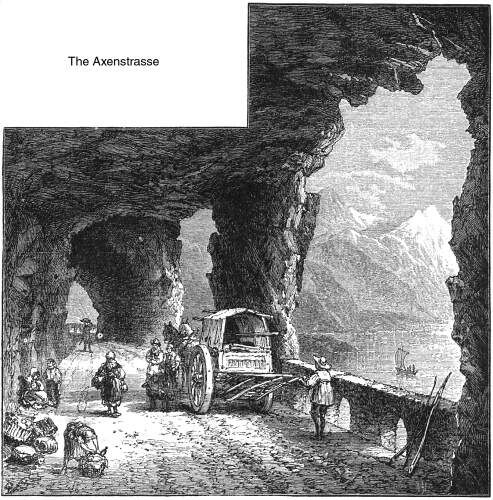 If the tunnel
be through hard rock, the arching is simple enough. A square hole
is driven in three or four feet wider and higher than the tunnel
will be when completed. Great wooden or iron bows or ribs, the
shape of the proposed arch, are then set in at short distances.
Over these half-circular ribs are laid timbers, reaching from
rib to rib, and running parallel with the tunnel. This forms,
then, a wooden arch open at the top. On this arch the masonry
is laid, additional timbers being placed on the ribs toward the
key-stone, or top, as the stone-work is built up. The open space
between the masonry and the earth is filled in as best it may
be with stones and wood to prevent the earth's sinking too suddenly
on the arch. The work is especially simple and easy when the arch
is put in in short sections. When the last wedge or key-stone
is placed, the supporting ribs and timber are pulled away, and
the stone arch stands complete. If the tunnel
be through hard rock, the arching is simple enough. A square hole
is driven in three or four feet wider and higher than the tunnel
will be when completed. Great wooden or iron bows or ribs, the
shape of the proposed arch, are then set in at short distances.
Over these half-circular ribs are laid timbers, reaching from
rib to rib, and running parallel with the tunnel. This forms,
then, a wooden arch open at the top. On this arch the masonry
is laid, additional timbers being placed on the ribs toward the
key-stone, or top, as the stone-work is built up. The open space
between the masonry and the earth is filled in as best it may
be with stones and wood to prevent the earth's sinking too suddenly
on the arch. The work is especially simple and easy when the arch
is put in in short sections. When the last wedge or key-stone
is placed, the supporting ribs and timber are pulled away, and
the stone arch stands complete.
But to return to the tunnel. If we push forward from where
we are, we will soon have a good view of an air boring-machine
at work. It may be described as a large oblong iron frame-work,
some seven feet wide, six feet high, and ten feet long. It stands
on a bit, of railway, built in for the purpose, close to the rock.
To the sides of this iron frame are clamped little gun-metal cylinders,
supplied with compressed air from the air tube running in from
the compressors outside the tunnel. To the ends of the extending
pistons of these little cylinders are fastened the long iron drills,
which are driven into the rock at the rate of 150 strokes each
per minute. There is no boring, in a proper sense; it is simply
drilling. A simple contrivance on the piston causes it to turn
over and over as the drilling progresses. These machines punch
holes into the rock about four feet deep, and are then moved back
to a safe distance, while the holes so pierced are filled with
long cartridges of dynamite to be fired by fuses. During the drilling
the noise of the machines is almost deafening. Nobody pretends
to hear a word. Every order is given by gesture. When the explosion
occurs it is not only a tremendous noise, but a tremendous heat
and smell as well, which even the stout miners could not long
submit to and live.
The compressed air is now allowed to escape from the cylinders,
the cocks to the main air tube are left open, and the foul odors
are gradually pushed to the rear. The debris is removed as quickly
as possible, the track for the machine is laid closer up to the
breast of the granite, and again commences the rattling of the
drills.
Under favorable circumstances this advanced gallery or heading
has been driven forward as much as eighteen or nineteen feet per
day at each end of the tunnel. The average, however, is not above
ten and a half feet per day, or twenty-one feet advanced for the
two ends.
The tunnel which I have been describing is, of course, the
main one of the series through these mountains. There are, however,
as has already been observed, others nearly joining it, some of
which are 6000 feet and more in length; and the sum total of what
might properly enough be called the tunnel of the St. Gothard
measures but little less than twenty-three English miles. Seven
of the tunnels in this series will be built in a spiral or auger
form, for the purpose of bringing the line up great elevations.
Passenger trains may thus enter the foot of a mountain, and, by
winding about in a sort of a railway staircase for a time, emerge
a couple of hundred feet higher up. There will be four of these
railroad stairways on the Italian side of the tunnel, between
Giornico and Fiesso. This method of taking trains up mountains
by means of spiral tunnels inside is the invention of Mr. Hellwag,
the engineer-in-chief.
There are probably 3500 persons, including officers, engineers,
draughtsmen, etc., engaged upon the tunnel. The common workmen,
as already noticed, are all Italians. Many of the officers and
engineers are Swiss; a few are Germans. Mr.Hellwag, the chief
of affairs, is a native of Schleswig-Holstein, and is a distinguished
railway engineer. Mr. Favre, the contractor, is a Swiss.
I have purposely omitted all mention of the Italian side of
the tunnel for the reason that the principle on which it is being
worked is exactly the same as is pursued at the Swiss side, and
the general control is in the hands of the same engineers.
When the St. Gothard road is completed, it will, in some respects,
offer the most tempting railroad ride in the world. The scenery
through which it passes, especially at the Axenstrasse, on Lake
Lucerne, is as grand as any in Switzerland. It will pass within
a rifle-shot, too, of Rutli, Burglen, Altorf, and other spots
made famous by the deeds of Tell. Pretty little Airolo and castled
Bellinzona will be halting places, and trains will pass over mountain
spurs half as high as the Righi. A couple of short hours' ride
will take the traveller from the edges of the glaciers in Switzerland
down into the sunny plains of Lombardy; and should proper connections
be arranged, the Swiss merchant may go to bed in a Pullman car
at Zurich, and wake up with the early morning at Venice on the
Adriatic.
Mountain Railroading
| Contents Page
|







